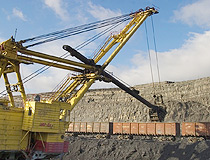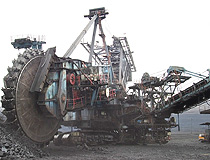Kazakhstan coal industry history
Kazakhstan people call the steppe situated in the heart of Kazakhstan Sary-Arka, the Yellow Steppe. One day Appak Baizhanov, a marmot hunter, decided to build a fire here. To his amazement, some stones caught fire together with the brushwood. This happened in the mid-19th century.
When the rumor of the combustible black stones reached the ears of Russian merchant named Ushakov (who, unlike the nomads, knew the value of coal), he bought the plot of land for a song from a Kazakhstan landowner, and soon sold it to the son of President Carnot of France. The latter resold the land at a profit to British, who opened two collieries here.
When copper deposits were found near Karaganda, it was again foreigners who took possession of them. Soviet government nationalized both Spassk copper smeltery, which was considered a large enterprise in those days, and Karaganda coal mines, which supplied the smeltery with fuel, as well as other enterprises owned by foreign and Russian capitalists.
Kazakhstan coal industry facts
Karaganda coal basin, whose development was launched as far back as 1930, has long been Kazakhstan’s main coal supplier. It still produces up to 50 million tons of the “black stone” annually. Two hundred kilometers to the northeast of Karaganda, not far from the city of Pavlodar on the river Irtysh, are Ekibastuz coalfields, which are among the largest in Kazakhstan.
Kazakhstan contains Central Asia’s largest recoverable coal reserves, with 37.5 billion short tons of mostly anthracitic and bituminous coal. Kazakhstan produced 86 million short tons (Mmst) in 2003, while consuming 58 Mmst, resulting in net exports of 28 Mmst. Russia is the largest importer of Kazakh coal, followed by Ukraine.
Kazakhstan coal production, which was the Soviet Union’s third-largest producer behind Russia and Ukraine, has fallen by roughly 35 percent since independence. According to Kazakhstan Ministry of Energy and Natural Resources, the country aims to be producing 100 million-105 Mmst annually by 2015.
Much of the decline in the last decade since independence has been due to mine problems (over 30 people died in mining accidents during 2004) and problems obtaining outside foreign investment to maintain their economic viability. This latter factor will be crucial in obtaining Kazakhstan government’s long term production targets.
Kazakhstan’s largest coal producer, Bogatyr Access Komir, which accounts for roughly 35 percent of Kazakhstan’s coal output, is a subsidiary of Access Industries Incorporated (U.S.A.). Bogatyr Access Komir develops northern Kazakhstan’s Bogatyr and Severny coal fields and is Kazakhstan’s largest exporter to Russia. Russian firms are also stake holders in Kazakhstan coal industry and roughly 16 Mmst are transited annually from Kazakhstan northward via rail to power plants in southern Russia.
Since independence, Kazakhstan coal consumption has fallen from 97 Mmst in 1992 to 58 Mmst in 2003. As a percentage of total energy consumption, coal accounted for 52 percent in 2002, up slightly from 50 percent in 1992. The majority of Kazakhstan’s electric generating plants are coal-fired, including Kazakhstan largest power generator, Ekibastuz No.1, located in north-central Kazakhstan.






